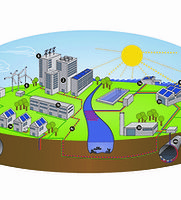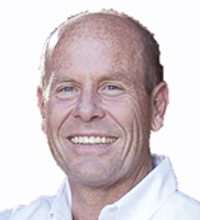Geothermal prime time

In the movie, "Back to the Future II," during his visit to 2015, Marty purchases a 1950 to 2000 sports almanac, hoping to bring it back to the year 1985. That year would open the door to the potential for an advantage and some extra "earning potential."
The 2015 bad guy character "Biff" ends up stealing the almanac and bringing it back to Biff’s younger 1955 self. This is a fun story line, point being that they knew that armed with the information in the sports almanac, they would be betting on a sure thing. We've all thought of the potential to capitalize on "sure-things," and in hindsight, there are plenty of things I would do differently had I known better.
One good way to capitalize is to watch trends. One particularly prominent trend is the growth and expansion of renewable energy technologies. Solar energy and wind generation have been successful; however an even better "sure-thing" is geothermal HVAC technologies. Geothermal exchange has grown more slowly, but that's about to change.
If you could get in on the ground level of a technology that had nearly infinite potential, and was limited to the mechanical professions/trades, you'd do it. Wouldn't you? Here are a couple of items that are trending now:
At the National Geothermal Convention in Baltimore on October 15, Bosch Thermotechnology's president stated that the number of geothermal HVAC trained and certified professionals will grow from 3,000 members to between 30,000 and 40,000 over the next few years, to accommodate growth. With growth potential of better than 1,000 percent, I'd say geothermal is a sure thing.
On November 13, I attended the Long Island Geothermal Exchange Organization's (LI-GEO) Annual Conference, where they hosted a press conference. County Executive Steve Bellone joined the Suffolk County Planning Commission, PSEG Long Island (the local electric utility) and the Long Island Geothermal Energy Organization (LI-GEO) to announce the first uniform geothermal energy code for residential and commercial properties in New York State, and perhaps the U.S. Suffolk County did the same type of program with the solar industry three years ago resulting in 6,000 solar and PV installations, dwarfing the number of installations from the previous 10 years.
Among those on hand and likely to be following the example of Suffolk County were officials from the New York Geothermal Energy Organization (NY-GEO). Other organizations to watch are the New England Geothermal Professional Association (NEGPA) and the New York State Energy and Research Development Authority (NYSERDA).
Geothermal HVAC is the way the industry is going, and right now is the perfect time to get in. Here are some pointers that will help you to get involved and claim your piece of a phenomenal growth market.
With geothermal, you'll be taking advantage of your current customer base and skillset, because geothermal exchange systems don't necessarily change the mechanical system inside the building. The underground geothermal exchanger is the new piece to most, so you'll want to identify a good partner with which to team up on the first projects you undertake. Depending on the project(s) you've identified, you will likely need one or more other local professionals to assist you on the first few projects. A good geothermal professional will help you to complete a competent ground source exchanger outside to complement what you're probably already doing for the building inside.
A geothermal exchange professional will likely have knowledge of the geological conditions and be able to identify the needs and pricing to complete the underground geothermal exchanger installation.
Construction knowledge on the part of your geothermal partner is a big plus, taking the first time jitters and guess-work out of the process. Generally, there is a learning curve on anything we try the first time. So, it's a good idea to watch and learn on the first couple of go-rounds.
Many manufacturers have a line of geothermal/water sourced equipment. You'll want to select a brand that can support your efforts in a wide variety of markets.
On larger projects, owners sometimes need a level of comfort that may not be quite there yet. Even when geothermal exchange has been proven as effective and efficient at a local level, some require a feasibility report be completed for further assurances. That information is available and can be applied to specific projects effectively. Just contact the geothermal industry organizations; they are there to help you succeed.
Like many before you, the first couple of geothermal projects undertaken will and should be scrutinized closely, after which a level of comfort is gained. Once you've reached that level of confidence, you'll want to "take the reins" by attending geothermal exchange training for your company's benefit and to provide certification for your efforts going forward. This is the point at which you can be listed on the geothermal industry websites as a geothermal professional/contracting entity, providing the same help to clients and fellow professionals according to your own wishes. The International Ground Source Heat Pump Association (IGSHPA) and the Geothermal Exchange Organization (GEO) are your resources for all of these efforts. These are the groups to which you and others can and should go to get information, training and list your company as a geothermal heating and cooling entity.
Let's take a look at some potential geothermal projects that might be perfect for you. Refer to the graphic "Geothermal City" at the beginning of the article and use the key to identify the numbered items: www.egshpa.com/news-media/news/the-perfect-geothermal-city/
Key to Geothermal City:
1. Heat pumps in single-family houses
a. Heat pumps in multi-family houses
2. Heat pumps in office and commercial buildings
3. Industrial use of heat pumps
a. Source for district heating
b. Process energy
4. Heat pump use in and for infrastructure
a. Subways/tunnels
b. Sewage systems
c. Energy grid (district heating or "cold source")
5. The building structure as heat exchanger
a. Heat piles
b. Activated concrete
6. Heat pumps as storage for green electricity
Most of the information in this article has been compiled from excerpts and illustrations from the textbook, Modern Geothermal HVAC Engineering and Controls Applications, McGraw-Hill Education. l
Jay Egg is a geothermal consultant, writer, and the owner of EggGeothermal. He has co-authored two textbooks on geothermal HVAC systems published by McGraw-Hill Professional. He can be reached at jayegg.geo@gmail.com.





